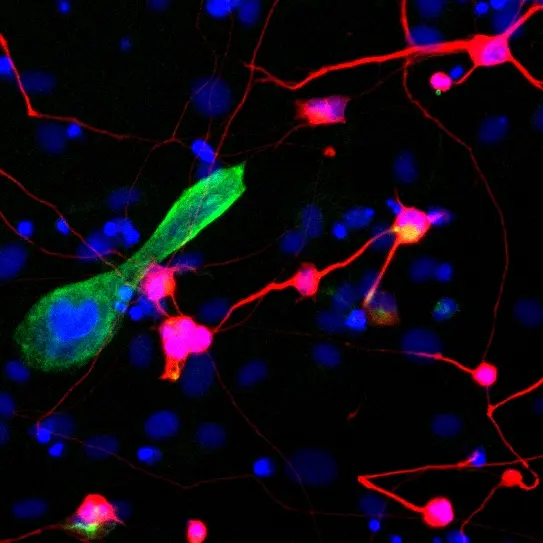Transcription factors can switch on individual genes and are thus enabling cells to develop their specialized identity and function in the body. Some of these factors can even change or re-programme the identity of the cells, for example when they are artificially introduced into cells by viruses. Using this technology, scientists can already reprogram skin or blood cells into nerve or stem cells and use them for research into diseases.
Moritz Mall at the German Cancer Research Center (DKFZ, HITBR) and Qian Yi Lee at Stanford University compared two transcription factors that are structurally similar but induce completely different cell types. The factor Ascl1 can program skin cells into nerve cells, while Myod1 can convert skin cells into muscle cells.
Since transcription factors normally exert their effect by binding certain gene switches, the researchers first investigated the DNA binding sites of both factors. Although Ascl1 and Myod1 induce very different cell types, both surprisingly bind to largely overlapping recognition sequences in the mouse genome. This is true both during reprogramming and during normal cell differentiation. “For us, this was an indication that other mechanisms must be involved to ensure that only the desired genes are regulated,“ explains Mall. In fact, further analyses showed that despite the overlap, Ascl1 and Myod1 each attached to specific regions of the genome with stronger binding power.
“We were able to decipher on a molecular level how the pioneer factors Ascl1 and Myod1 function and that they are also prone to errors due to their incredible binding power,“ explains Moritz Mall. “That's why co-factors like the Guardians are important: they keep the pioneer factors in check. Mutations in guardian factors are associated with diseases such as cancer, which underlines their important role.“
The scientists want to use their new findings to produce specific cell types for research with even greater precision. Their future goal is to be able to investigate brain diseases in the culture dish in the future.
The work at the DKFZ and HITBR was funded by the Hector Foundation II and the European Research Council ERC, among others.
Qian Yi Lee, Moritz Mall, Soham Chanda, Bo Zhou, Kylesh S. Sharma, Katie Schaukowitch, Juan M. Adrian-Segarra, Sarah D. Grieder, Michael S. Kareta, Orly L. Wapinski, Cheen Euong Ang, Rui Li, Thomas C. Südhof, Howard Y. Chang, Marius Wernig: Pro-neuronal activity of Myod1 due to promiscuous binding to neuronal genes.
Nature Cell Biology 2020, DOI: 10.1038/s41556-020-0490-3
A picture is available for Download:
MyoD3.jpg
Photo caption: “Pioneer factors“ reprogram connective tissue cells in the culture dish to become nerve cells (red) and muscle cells (green).
Note on use of images related to press releases
Use is free of charge. The German Cancer Research Center (Deutsches Krebsforschungszentrum, DKFZ) permits one-time use in the context of reporting about the topic covered in the press release. Images have to be cited as follows: “Source: Mall/DKFZ“.
Distribution of images to third parties is not permitted unless prior consent has been obtained from DKFZ's Press Office (phone: ++49-(0)6221 42 2854, E-mail: presse@dkfz.de). Any commercial use is prohibited.



